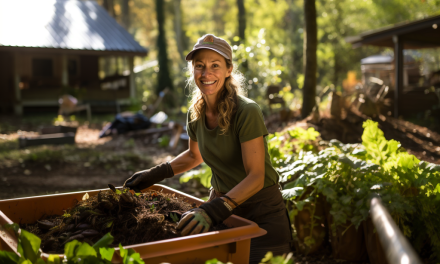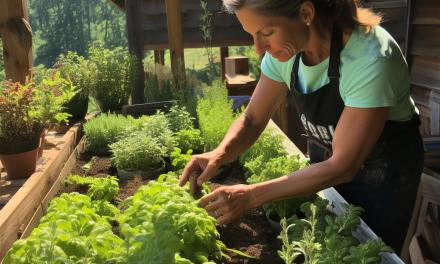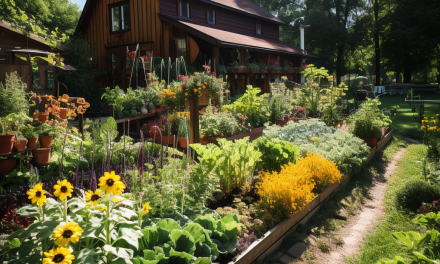7 High-Calorie Crops to Fuel Your Garden and Your Body
Hello dear readers! I’m Gayle, your gardening enthusiast, and I’m thrilled to be sharing some incredible insights with you today. 🌱🌞
Have you ever wondered how many calories you can realistically grow in your garden? I certainly have! In fact, I embarked on a journey four years ago, a personal challenge to live off the bounty of my garden. And let me tell you, it was quite the experience. I lost about 12 pounds during that time, though most of it was muscle. But you know what they say, we learn from our experiences and improve. 💪
In today’s discussion, I want to dive deep into a topic that’s not just about gardening but about survival and sustenance. We’re talking about the caloric density of crops – the energy-packed, calorie-rich plants that can be the cornerstone of your survival garden.
Please note, this isn’t about nutrient density or how many different nutrients a crop contains. It’s about the energy you can harvest from your garden, and that’s a game-changer when it comes to self-sufficiency.
A Note on Variability 🌍🌱
Before we jump into our top seven high-calorie crops, let’s acknowledge that every garden is unique. Your climate, your soil, and your care all play a role in determining your harvest. So, think of these numbers as a rule of thumb, a baseline to inspire your garden dreams.
Now, without further ado, let’s explore the first crop on our list: Kidney Beans.
Pro-tip: Remember, your garden is as unique as you are. Embrace the journey, and let’s grow
Crop 1: Kidney Beans – Nature’s Protein Powerhouse 🌱💪
Welcome back, my dear readers! It’s time to dive into our first high-calorie crop: Kidney Beans. These beans have an incredible history, originating in Peru about 8,000 years ago. They’ve come a long way, and today, they’re not just a calorie source but a fantastic protein provider as well.
Growing Kidney Beans 🌱🌞
Kidney beans thrive in full sun, basking in the warm rays. They prefer a slightly sandier soil, so keep that in mind when planning your garden bed. And remember to keep the soil evenly moist, as these beans do love their hydration. If you’re growing fresh beans, pick them as they ripen. But if you’re aiming for dried beans, let them stay on the plant until they’re completely bone dry.
Calories in Kidney Beans 🥣📊
Now, let’s talk numbers. In a standard four by four square foot raised bed setup, you can expect around one to four kidney bean plants per square foot. That’s a yield of roughly two pounds of beans in that bed. But here’s the exciting part – those two pounds translate to a whopping 3,000 calories, with 800 of those calories coming from protein! Talk about a powerhouse ratio of protein to total calories. 🌟
Remember, you don’t have to limit yourself to raised beds. Kidney beans are versatile; you can grow them in bags, rows, or directly in the ground. I’ve even tried growing them in vertical planters! So, whether you’re tight on space or have a garden sprawling in all directions, kidney beans can find a home in your garden.
Pro-tip: Kidney beans can be a nutritious cornerstone of your survival garden. Their protein content makes them a valuable addition to your diet.
Crop 2: Sweet Potatoes – A Rootful of Goodness 🍠🌱
Hello again, my gardening companions! Now, it’s time to explore a crop that’s as sweet as it is nutritious – Sweet Potatoes. These wonderful tubers have a rich history, originating in Central and South America, and they’ve been nourishing people for centuries.
Growing Sweet Potatoes 🌞🌿
Sweet potatoes are a delight to grow, but they do need some love and care. They thrive in hot temperatures and prefer a long growing season. For these reasons, it’s wise to provide them with ample space, ideally in a large barrel or raised bed. Sweet potatoes are like nature’s treasure chest buried underground, so give them the room to spread their roots.
Calories in Sweet Potatoes 🌟🍽️
Now, let’s talk about the calorie bonanza that sweet potatoes offer. In a four-foot by four-foot bed, you can plant about one sweet potato slip per square foot. These slips are the shoots with roots that eventually form the tubers. With around 16 sweet potato slips in a single raised bed, you’ll be looking at a harvest of approximately 26 pounds of sweet potatoes on average.
But here’s the real kicker – that harvest packs a punch of calories, totaling just under 10,000 calories. That’s equivalent to five days’ worth of food if you follow the average daily calorie intake of 2,000 calories. It’s incredible how a single plant in your garden can provide such sustenance! 🌟🍠
Pro-tip: Sweet potatoes are versatile in the kitchen. Roast them, mash them, or make them into pies. You’ll never run out of delicious ways to enjoy this superfood.
Crop 3: Quinoa – A Nutritional Powerhouse for Your Garden 🌾🌱
Hello, fellow garden enthusiasts! Today, we’re shining a spotlight on a humble grain with an extraordinary nutritional profile – Quinoa. This ancient crop has its origins around Lake Titicaca in Peru and Bolivia and has been a staple in South American diets for centuries.
Growing Quinoa with Ease 🌞🌾
Quinoa is not just a nutritional powerhouse; it’s also a delight to cultivate in your garden. This resilient plant thrives with minimal water requirements, making it an excellent choice for areas with natural rainfall patterns. It prefers loose, lowly soil and is relatively easy to care for, making it a perfect addition to your survival garden.
Calories in Quinoa 🥣📊
Now, let’s talk about the calorie potential of quinoa. In a four by four square foot bed, you can plant up to four quinoa plants per square foot. These plants can produce about eight pounds of quinoa per bed if grown well. And here’s the exciting part – that translates to a whopping 13,550 calories in a single four by four bed. Quinoa is one of the most calorically dense crops you can grow, and it’s worth every effort!
Pro-tip: Quinoa is not just about calories; it’s rich in essential nutrients. It’s a complete protein source, making it an excellent addition to your diet.
Crop 4: Potatoes – Nature’s Versatile Calorie Source 🥔🌱
Welcome back, dear readers! Today, we’re talking about a crop that’s close to my heart and a staple in many households – Potatoes. These humble tubers have a fascinating history and are incredibly versatile in the kitchen.
The Art of Growing Potatoes 🌞🥔
Growing potatoes can be a delightful experience. They are one of the most adaptable crops you can grow in your garden. Whether you have a spacious raised bed, a five-gallon bucket, or even a grow bag, potatoes can find a home. The key is to be patient because these plants need to die back almost completely before harvesting. That’s when all the energy and moisture have gone down into those plump tubers.
Calories in Potatoes – A Bountiful Harvest 🌟🍽️
Now, let’s talk numbers. In a four by four square foot bed, you can plant approximately 12 potatoes. If grown perfectly, each plant can yield about five to seven potatoes, with each potato weighing up to a pound. That means you could be looking at roughly 80 pounds of potatoes per bed!
But here’s what truly amazes me – that 80 pounds translates to around 22,000 to 23,000 calories. Potatoes are not just versatile in the kitchen; they are calorie-packed powerhouses in your garden!
Pro-tip: Potatoes are perfect for experimenting in the kitchen. Whether you’re making mashed potatoes, roasted potatoes, or potato pancakes, there’s no end to the delicious possibilities.
Crop 5: Amaranth – The Nutritional Secret in Your Garden 🌱🌾
Hello again, my fellow gardening enthusiasts! Today, we’re uncovering a hidden gem in the world of high-calorie crops – Amaranth. This beautiful grain crop has a fascinating history, and its value in your garden goes far beyond its appearance.
Growing Amaranth with Grace 🌞🌾
Amaranth, much like quinoa, is a grain that’s as striking to look at as it is easy to grow. Its origins trace back to the Inca and Aztec peoples, who cherished it for its beauty and nutrition. When cultivating amaranth, you’ll want to pay attention to its watering needs. If you’re in an area with a natural rainfall pattern, be sure not to overwater it. Amaranth thrives with minimal moisture, especially when seedheads are forming.
Calories in Amaranth – A Hidden Treasure 🌟🍽️
Now, let’s explore the calorie potential of amaranth. In a four by four square foot bed, you can sow about four amaranth plants per square foot. When grown well, each of these plants can yield around six ounces. So, in that bed, you can expect to harvest approximately eight pounds of amaranth. But here’s the exciting part – that eight pounds translates to a significant 28,000 calories in just one bed!
Pro-tip: Amaranth seeds require some processing to become edible, but the effort is well worth it for the high-calorie reward.
Crop 6: Jerusalem Artichokes – A Caloric Boost with a Twist 🌱🌻
Welcome back, my gardening companions! We’ve explored some incredible high-calorie crops, and now, we’re about to dive into the world of Jerusalem Artichokes. These unique tubers, affectionately known as “fartichokes” for some, are not only easy to grow but can be a significant source of calories.
Growing Jerusalem Artichokes with Vigor 🌞🌱
Jerusalem Artichokes are the champions of low-maintenance gardening. They thrive with minimal attention, making them perfect for the “set and forget” approach. However, a word of caution: these tubers are prolific and can spread rapidly. It’s a good idea to grow them in containers or raised beds to keep them in check.
Calories in Jerusalem Artichokes – A Surprising Bounty 🌟🍽️
Now, let’s talk about the calorie potential of Jerusalem Artichokes. In a four by four square foot bed, you can plant just one tuber per square foot. But here’s where it gets interesting – each single tuber can produce at least 20 more tubers! That’s right, they multiply like wildfire. In that single bed, you can expect to harvest about 35,000 calories worth of food!
Pro-tip: Be aware that Jerusalem Artichokes may not agree with everyone’s digestive system. They are undoubtedly calorie-rich, but consider your personal tolerance before growing them in abundance.
Crop 7: Rice – A Global Staple for Your Survival Garden 🌾🌱
Hello again, my dear readers! We’ve reached the final crop on our high-calorie journey, and it’s a beloved staple in many cultures around the world – Rice. This versatile grain has nourished billions of people for generations, and it holds a special place in my heart.
Growing Rice with Care 🌞🌾
Rice is often associated with vast paddies and watery fields, but you can grow a variety called upland rice in your garden, even without a pond. All you need is rich soil, consistent moisture (never let it dry out!), and a healthy dose of sunlight. In a four by four square foot bed, you can plant a whopping 15 rice plants per square foot.
Calories in Rice – An Abundance of Energy 🌟🍽️
Now, let’s talk about the calorie potential of rice. With 15 rice plants per square foot, you can harvest around 80 pounds of rice from a single raised bed. That’s a treasure trove of calories, totaling nearly 48,000 calories. It’s a testament to the incredible potential of this global staple.
Pro-tip: Rice is not just about calories; it’s a canvas for flavors. Experiment with different seasonings and pair it with your favorite dishes to create delicious meals.
Embrace the Power of a Survival Garden 🌿🌎
Dear readers, as we conclude this journey through calorie-rich crops, I want to leave you with a profound reflection. In these uncertain times, where the world can sometimes feel unpredictable and the cost of living continues to rise, the concept of self-sufficiency becomes ever more crucial.
A Resilient Source of Nourishment 🍅🥕
A survival garden is not just a patch of earth with plants; it’s an oasis of resilience. It’s a testament to your ability to take control of your own nourishment, to stand strong in the face of supply chain disruptions, and to ensure the well-being of your loved ones.
Gardening as a Form of Self-Sufficiency 🌱💪
With inflation knocking on our doors and uncertainties looming, growing your own high-calorie crops isn’t just a hobby – it’s a practical skill that can sustain you when you need it most. It’s a way to put food on the table without relying solely on external sources.
Nurturing Both Garden and Soul ❤️🌻
A survival garden isn’t just about the calories; it’s a reflection of your connection to nature, your love for gardening, and your dedication to nurturing life. It’s a beautiful journey that feeds both your body and your soul.
Embrace the Challenge 🌟🌿
So, my dear readers, I encourage you to embrace the challenge of creating and maintaining your survival garden. Cultivate it with love, care for it with dedication, and let it stand as a symbol of your self-sufficiency, resilience, and the power of nature.
In uncertain times, your garden can be a source of certainty, a wellspring of nourishment, and a reminder of the strength that lies within you.
Until next time, may your survival garden flourish and may you thrive in the face of whatever challenges may come your way.
Warmest regards, Gayle 🌿❤️
Amazon and the Amazon logo are trademarks of Amazon.com, Inc, or its affiliates.AMAZON AFFILIATE DISCLOSURE The Garden Whisperer Tips blog is a participant in the Amazon Services LLC Associates Program, an affiliate advertising program designed to provide a means for sites to earn advertising fees by advertising and linking to Amazon.com. As an Amazon Associate, we earn from qualifying purchases. Some of the links on this blog are affiliate links, and if you go through them to make a purchase, we will earn a commission at no extra cost to you. AFFILIATE MARKETING AND ADVERTISEMENT TRANSPARENCY At Garden Whisperer Tips, we believe in full transparency with our readers. We participate in multiple affiliate marketing programs, and some of the links on this blog may be affiliate links. This means we may earn a commission if you click on the link or make a purchase using the link. We also host advertisements on our blog, which helps us generate revenue. Rest assured, our editorial content is not influenced by advertisers or affiliate partnerships.





